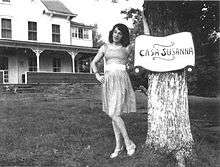Casa Susanna
Casa Susanna was a popular weekend destination in Jewett, NY[1] for cross-dressing men and transgender women in the early 1960s. The bungalow camp was run by Susanna Valenti[2] and her wife Marie, who also ran a wig store in town.[1]

History
Marie purchased the 150-acre property in the mid-1950s, and she and Susanna originally dubbed it Chevalier D'Eon Resort.[3] They charged $25 for a weekend, which included food, lodging, and makeup lesson. Hidden away in the rural Catskills, Casa Susanna provided much-needed privacy to its guests in a time when publicly cross-dressing was a criminal offense. However, guests occasionally visited the town of Hunter to shop, where they were met by a range of reactions. Some were negative, but many locals saw them as reliable customers.[4] Casa Susanna was a haven for its guests to go to and celebrate their "inner girl" without persecution. There, they could be happy and comfortable, participating in activities like gardening and Scrabble in elegant 1950s-style heels and dresses.[5] Most guests at Casa Susanna were married and considered themselves heterosexual men who enjoyed cross-dressing, but many others later identified as transgender and lived out their lives as women, including Virginia Prince and Susanna herself.[1]
Photography for transvestites in the 1950s was both affirming and extremely dangerous. Sending negatives to a professional developer who might call the police was out of the question, so Casa Susanna appointed an official photographer from one of its own: Andrea Susan. Andrea took many photographs of her fellow guests and developed them at home.[6] Although Polaroids were popular for their instantaneous development, Andrea's photography was of higher quality, and she could be trusted. She put the negatives in the possession of her mentor Dick, who had gifted her her photo development equipment. When Dick threw them away, they made their way to a Manhattan flea market in the mid-2000s. There, they were found by Robert Swope,[7] “a gentle punk rocker turned furniture dealer,” who bought every photograph he could find and published them into a book with his partner Michel Hurst.[6] The release of this book fifty years later led many former attendees of Casa Susanna to come forward and share their experiences, allowing the resort to be documented. Without this chance encounter, Casa Susanna may have been lost to history.
Influence
The book Casa Susanna which was a collection of photographs from the home inspired the Tony-nominated play Casa Valentina by Harvey Fierstein.
See also
References
- "Google Maps". Retrieved 2019-04-22.
- Susanna Valenti (born Tito, a name which she went by for many years) immigrated to the United States from Latin America in the mid-1940s. She wrote numerous articles for Virginia Prince's Transvestia. Susanna's time and place of death are unknown: the last known mention of her was her contribution to the 100th issue of Transvestia in 1979.
- Zagria (2012-02-01). "Susanna Valenti (192? - ?) translator, broadcaster, activist". A Gender Variance Who's Who. Retrieved 2017-03-13.
- Blotcher, Jay. "Queens of the Catskills". Chronogram Magazine. Retrieved 2017-03-13.
- TIME. "Casa Susanna: Photographs From a 1950s Transvestite Hideaway". Time. Retrieved 2017-03-13.
- "The Historical Roots of Casa Valentina | Chrysalis Quarterly". dallasdenny.com. Retrieved 2017-03-13.
- Not the Robert Swope of Vagina Monologues fame.